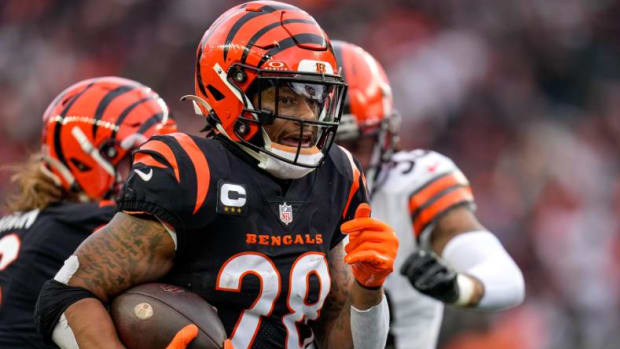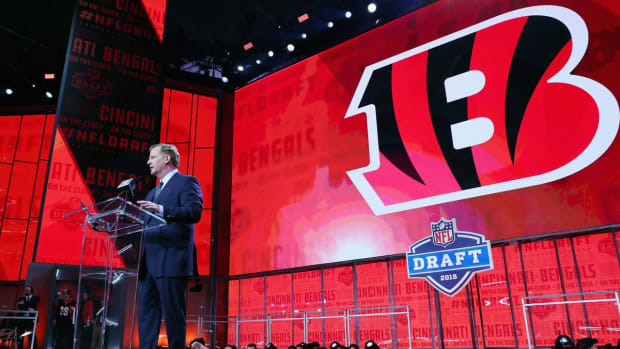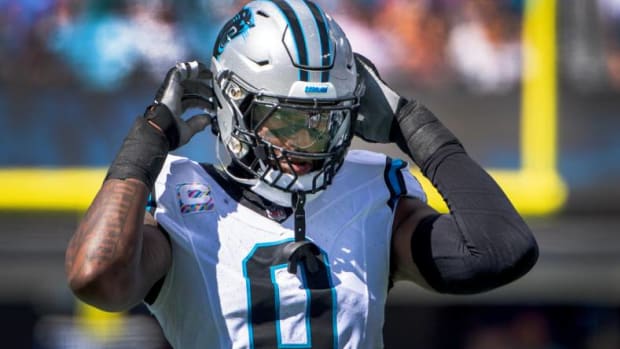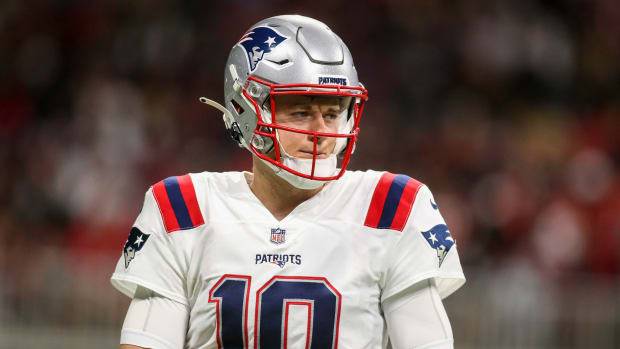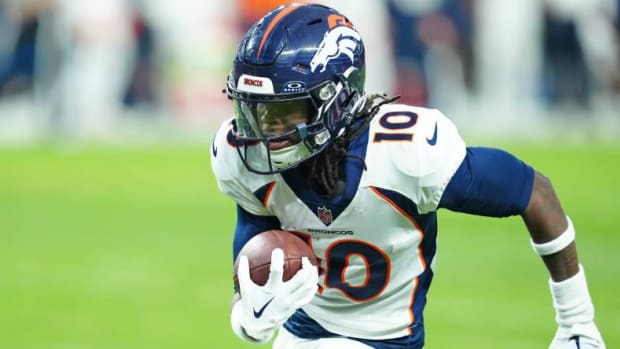Rookie Spotlight: Philadelphia Eagles OT Jack Driscoll
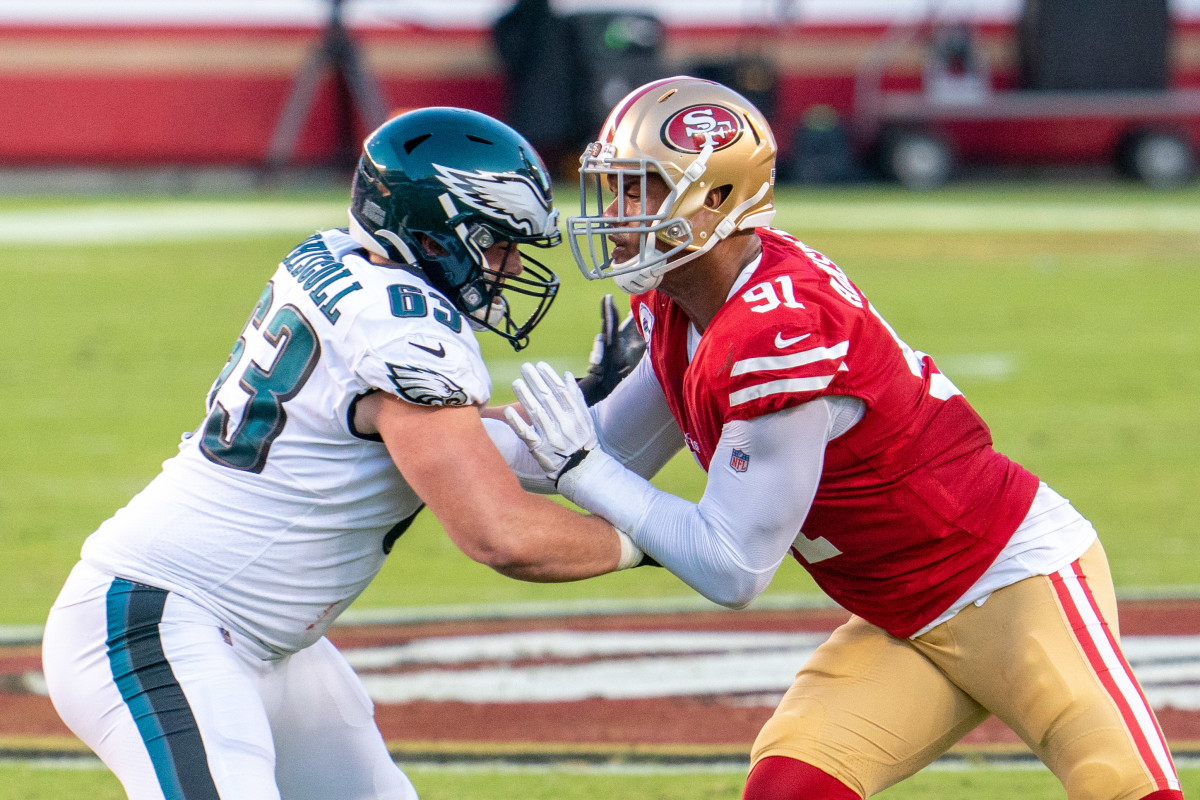
The group of offensive tackles in the 2020 NFL Draft featured several big names and high-level players. As the 2019 college football season wore on, four offensive linemen established themselves as the consensus top tackles in the class: Jedrick Wills of Alabama, Andrew Thomas of Georgia, Tristan Wirfs of Iowa and Mekhi Becton of Louisville. Although these four athletes were considered top-tier prospects, there was talent to be found elsewhere in the 2020 offensive tackle class.
Austin Jackson of USC and Isaiah Wilson of Georgia, for example, were widely believed to be future starters and early contributors in the league. Although injuries were seen as deleterious to his NFL projection, Prince Tega Wanogho of Auburn was seen as an excellent athlete with the potential to develop into a starter. Although less known and at times overshadowed by his teammate, Jack Driscoll of Auburn proved he was a steady, reliable player and a strong prospect in his final college season.
It did not take long into the 2020 NFL Draft’s first round for offensive tackles to start coming off the board. Thomas heard his name called first, as the New York Giants selected him fourth overall. Just six picks later, the Cleveland Browns chose Wills at ten. With the 11th pick, the New York Jets took Becton. Shortly thereafter, the Tampa Bay Buccaneers ended Wirfs’s wait after trading up for the 13th selection.
Later in the first round, Jackson and Wilson were taken with the 18th and 29th picks, respectively. Through three rounds, Driscoll had not heard his name called. The fourth round had nearly come and gone as well when the Philadelphia Eagles chose the Auburn offensive tackle with the draft’s 145th selection. Driscoll was taken two rounds ahead of Wanogho, who was also drafted by the Eagles.
Unlike some other NFL Draft prospects, the Auburn right tackle’s path to the league was not clear-cut. Driscoll started his career at the University of Massachusetts in 2015. After redshirting his first year, he started eight games primarily at guard in his redshirt freshman campaign. In his second season, he started all twelve games for the Minutemen at right tackle. In recognition of his stellar performance, Driscoll was named All-ECAC Second Team by conference coaches and All-Independent First Team by Phil Steele.
After his redshirt sophomore season, the Massachusetts product grad transferred to Auburn in time for the 2018 year and quickly earned the starting job. In his first year at Auburn, Driscoll was put on the AD Honor Roll and the First-Year SEC Academic Honor Roll. Before the 2019 season, Pro Football Focus named the now-incumbent starter to its Preseason All-SEC Second Team while the Reese’s Senior Bowl named him to its watch list. After his final campaign with the Tigers, Driscoll solidified himself as one of the draft’s top seniors with an invitation to the East-West Shrine Game.
Further, the National Football Foundation (NFF) nominated him for its Campbell Trophy, awarded to college football players for their work on the field, in the classroom and in the community. The NFF also nominated him for its postgraduate scholarship. What’s more, he earned his spot in the SEC Academic Honor Roll and the NFF Hampshire Honor Society. Finally, Driscoll’s impact on the Tiger football program earned him the Cliff Hare Award, given annually to an Auburn senior student-athlete in recognition of their academic and athletic success in addition to their leadership, integrity and courage.
Clearly a notable individual off the field, the former Minuteman was an accomplished college tackle thanks to his athleticism and controlled style of play. He used technique and patience to fill in any gaps in his power.
At the point of engagement, the Auburn tackle exhibited the requisite power to earn a role in the NFL. Driscoll blocked with a wide base and drew strength from his lower body. As a result, he rarely gave up ground in pass protection. In the run game, he attacked with high leg drive and consistently stalemated or even forced defenders back off the ball. What’s more, Driscoll generally used his wide base and grip strength to sustain blocks for extended periods.
Although his movement skills were not elite by any means, the academic standout was an impressive athlete with solid footwork. Driscoll was fairly quick out of his stance and was even able to mirror high side rushers.
As a run blocker, he had the short-area burst to pull and lead block or to climb to the second level. Driscoll also had the footwork and fluidity to hinge and seal defenders out of gaps. The tackle typically maintained a wide base throughout blocks, which enabled him to drop an early anchor.
The Massachusetts transfer also maximized his athletic traits with hand placement. Driscoll’s accurate punches helped compensate for any limitations in power. Further, the young tackle had quick hands, enabling him to re-engage should his first punch be swiped or batted away. Hand placement is a crucial aspect of offensive line play and Auburn’s young offensive tackle was generally efficient in that area.
In addition to his athleticism and technique, the young tackle regularly exhibited above-average awareness. Driscoll was a patient blocker who typically waited for pass rushers to show their hand before engaging. Moreover, he regularly set his base before contact to stay under control. In pass protection, Driscoll understood when to engage and disengage to best maintain his gap.
Despite his all-around solid play, the young tackle did not have any overwhelming or outstanding traits. In fact, his performance at the college level was consistently sufficient but rarely eye-catching.
The most notable concerns surrounding the senior’s game were his size and length. Driscoll was listed as sub-300 pounds on Auburn’s roster. Moreover, his arms measured in at an underwhelming 33” at the NFL Combine; the length concerns were present in his film. His short arms made it difficult to control the distance of engagement. As a result, defenders were able to get into his frame too often before working through him.
The negative effects of his limited length were only exacerbated by unspectacular power. Driscoll’s blocks were shed by active hand usage and high motors due to his combined shortcomings in arm length and strength. Specifically, these traits left him vulnerable to push-pull moves.
Although an above-average athlete, the former Massachusetts tackle had trouble handling lateral quickness. Specifically, he struggled to stay in front of quicker, more flexible pass-rushers who changed direction suddenly and sharply. This was especially the case when speed rushers complemented their movement with hand usage.
While the senior’s hands were accurate and effective in college, there were reasons for concern on film regarding his hand strength. Although he had fast hands to reengage, his punches were too easily knocked away. This, in turn, allowed defenders an opening to get into his chest or to work around him.
The young tackle also struggled with leverage and flexibility. He tended to play with a high pad level which reduced his functional power. Further, he did not have the requisite flexibility in his midsection to roll his hips through his blocks which, if done properly, manufactures power.
Although his feet were generally sound through engagement, the fifth-year senior had inconsistencies in his lower half. For example, he regularly took a false step out of his stance as a run blocker. Additionally, Driscoll struggled to regain his composure and balance when put onto his heels. While it did not happen often, this was a high-risk trait for his NFL projection considering his tendency to allow defenders into his frame. As a result of these nuances in his base, Driscoll found himself on the ground too often.
The Auburn Tigers’ issues with length and balance conflated into a concerning tendency to engage with poor weight distribution. To compensate for his shorter arms, Driscoll blocked out ahead of his center of gravity far too often. This action leaves blockers vulnerable to be misdirected or whiff altogether.
Finally, the tackle’s awareness had its limitations. Driscoll’s biggest mental issue was an inability to consistently identify and pick up stunts. Similarly, he could lock onto the first defender to attack his gap before subsequently failing to identify a delayed rusher.
To enter the NFL in 2020 would be a daunting task for any rookie. This was undoubtedly the case for Driscoll. The fourth round compensatory pick had a limited and confusing first offseason with the Eagles, thanks in large part to the COVID-19 pandemic. Still, the rookie made his presence felt in what little preseason training camps were available.
Driscoll played well enough to earn a backup role and even start several games along an offensive line riddled with injuries. By the end of the season, the Auburn product had started in four games - including Week One - and played 100% of the team’s offensive snaps in two games. Unfortunately, Driscoll’s season came to a premature end after the rookie suffered a sprained MCL against the New Orleans Saints. Although he was able to finish the game, the Eagles placed him on Injured Reserve in the week after the matchup.
In each of his first four starts, the young tackle exhibited high-level movement skills both in his pass sets and as a run blocker. Indeed, Driscoll is extremely quick out of his stance and covers substantial ground in very little time.
He mirrors defenders speed rushing his outside shoulder and has even stuck with defensive backs blitzing the C-gap. In the run game, Driscoll regularly climbs to the second level with ease and is, similarly, capable of pulling to lead block from the backside. The former Tiger’s excellent movement skills also enable him to reach and engage linebackers in space.
In addition to his athleticism, the Auburn product’s success on the field was directly linked to his hands. Driscoll was most effective when he threw his initial punch with proper timing to initiate contact. Moreover, his consistently-accurate hand placement was key to maximizing his functional power. On snaps where the rookie engaged with proper hand technique, he displayed
improved strength and balance. What’s more, the young tackle has quick hands to reestablish contact, should his initial punch be batted away.
While the NFL’s speed is undoubtedly faster than that at which college football is played, the Eagles’ fourth-round selection operates with patience. Despite his limited length, the first-year tackle does not typically lunge out ahead of his frame. Instead, Driscoll waits for defenders to enter his range of influence before making his move. This allows the rookie to play under control and maximize his physical traits.
Although the former Tiger is put at a disadvantage if initially driven back, he has developed the ability to reset his base and drop a late anchor. This is especially important for a player of Driscoll’s profile, who may often be forced onto his heels thanks to his limited length. While this particular skill is still progressing, his improvement from his senior year to his rookie year is promising.
The conflation of these positive traits has enabled the young tackle to sustain blocks at the NFL level. Driscoll is far from a perfect player. That said, the combination of his movement skills, his hands, his patience and his still-developing balance give him a rosterable floor. Further, they give him the potential to develop into a starter.
Still a young player on a team with two established tackles, the Philadelphia Eagles likely did not intend to put their recent fourth-round pick on the field much during his first year. Still, Driscoll answered the call when injuries sidelined the incumbent starter, former Pro Bowler and All-Pro Lane Johnson.
What’s more, the rookie’s only four starts came against teams with high-level defensive linemen. His first career start, Week One of the 2020 season, pitted him against Chase Young, Ryan Kerrigan, Montez Sweat, Jonathan Allen, Da’Ron Payne and Matt Ioannidis. In his second start, he played Calais Campbell and Matt Judon. In his first set of back-to-back starts, he worked against Preston Smith, Za’Darius Smith and Rashan Gary, before facing off with Cameron Jordan and Trey Hendrickson. While Driscoll was far from a dominant force in these games, he looked like an NFL player - albeit one who needed serious work.
As his college career would indicate, the fourth-round pick also provides value in the form of positional versatility. Whether he develops into a starter or not, there are signs that Driscoll can fill multiple spots on a depth chart. He has already played significant snaps at tackle and should be able to slot in at guard if need be.
Although the rookie’s play was promising considering his draft stock, there were several weaknesses on film that he must address or learn to overcome.
No issue was more apparent on film than was the young tackle’s length. Driscoll struggles to initiate contact because he played with a considerable length disadvantage. This allows defenders to land hands on his chest and walk him back into the pocket. Moreover, it gives his opponents the chance to stack and shed his blocks against the run. Defensive linemen are regularly able to bench press the rookie. At that point, Driscoll is generally out of range and unable to reengage.
To compensate for his limited length, the Auburn product often leans into his blocks. While this solves the problem on the surface, it is a risky tendency because he struggles to recover when defenders redirect or dodge him. By putting himself off-balance, Driscoll allows defenders to work through him more easily.
At the point of engagement, the rookie did not consistently exhibit the requisite power to warrant unabated confidence. Driscoll does not provide a substantial push upon contact. Similarly, he can be driven back when defenders get into his chest. The former Tiger is, for this reason, particularly susceptible to speed-to-power moves. Moreover, the fourth-round pick can be thrown around and controlled at the point of engagement. While he has gotten better at reestablishing his base, Driscoll’s lack of power may hinder him in the future.
Another issue caused by the young tackle’s length occurs at the second and third levels of the defense. While Driscoll excels at climbing to meet defenders in space, he struggles to engage and sustain blocks once there. The rookie overcommits to his target and approaches too aggressively. In doing this, he allows defenders to knife inside and still work to the ball-carrier. What’s more, he does not have the arm length to recover and slow his opponents down.
While linemen can manufacture length and power through the use of leverage, the Auburn product regularly plays with a high pad level. Consequently, Driscoll often surrenders his chest to defenders. Thanks to his limited power, an opponent reaching the rookie’s frame is the beginning of the end on that particular snap. By learning to play with leverage, Driscoll could chip away at two of his most substantial shortcomings: his length and his strength.
Another way to overcome a length limitation is to engage with proper timing. Driscoll is at his best when he shoots his hands at the right time; however, he is inconsistent in successfully initiating contact and playing with the timing. This allows the defensive linemen to reach his chest and walk him back into the pocket.
It is also worth noting that the Auburn product’s poor footwork limits the effect his movement skills can have. Indeed, Driscoll regularly takes false steps out of his stance and wastes motion in his pass sets. Most of the time, the young tackle is quick enough to overcome the technical issues in his lower half. Still, it is a concern that should be addressed.
Although his patience to engage carried over from Auburn, the rookie is still adapting to the speed of the game. Specifically, he struggles to process and detect blitzers. Driscoll too often latches onto the first defender to cross his face. In doing this, he leaves a wide-open gap for delayed rushers to attack. Similarly, Driscoll fails to pick up stunts. In other words, the young tackle gives pass rushers a free run to his quarterback as a result of his still-developing awareness.
All this said, the fourth-round pick has shown serious signs of promise and has already proven that he can be a spot starter in the league. Moving forward, Driscoll looks like a swing offensive lineman capable of backing up both tackle and guard spots in a zone-blocking scheme. Although he must add mass and strength while simultaneously refining certain technical aspects of his game, Jack Driscoll is a valuable player thanks to his versatility and the starter potential derived from his high-level movement skills.
For a more in-depth read on his strengths and weaknesses in college, below you can read my 2020 NFL Draft scouting report on Jack Driscoll based on his play at Auburn:
STRENGTHS
The young tackle blocks with a wide base and an early-onset anchor. Moreover, Driscoll generates power from his lower body and does not easily give up ground in pass protection. The former Minuteman’s wide base and above-average grip strength allow him to sustain blocks at the college level. In the run game, Driscoll churns his legs and exhibits a willingness to drive defenders back from the line of scrimmage. While he is not always successful as a people mover, he is not easily walked back.
In addition to his anchor, the Auburn product has quick feet off the line. He quickly covers a substantial amount of ground in his pass sets. Driscoll’s movement skills allow him to mirror defenders in pass protection and as a run blocker. What’s more, he can pull and lead block from the backside C-gap. Similarly, he can climb to the second level and establish contact. The Auburn Tiger’s hips are loose enough that he can hinge and seal defenders out of gaps. Driscoll also tends to maintain a wide base through his movement.
The young tackle regularly helps himself with above-average hand usage. His hand placement is consistently inside and on the chest-pads, which maximizes his strength. Moreover, Driscoll has fast hands that allow him to quickly reengage after they are initially swiped away.
In pass protection, the accomplished athlete regularly exhibits the patience to allow pass rushers to make their move before he engages. Similarly, Driscoll regularly sets his base before blocking, even when pulling on a run play. This tendency keeps him under control and maximizes his efficacy. Driscoll has displayed the right mindset, always looking for someone to block.
WEAKNESSES
Above all else, the senior’s size is a bit concerning. At the NFL Combine, his length was below average - 33" arms. Naturally then, Driscoll does not play with great functional length and struggles to keep defenders away from his frame. As a result, his blocks can be shed by defenders with good hand usage. He is particularly susceptible to push-pull moves.
While his biggest shortcoming is his length, the young tackle’s strength must also improve. Driscoll’s power is solid-but-unspectacular. At the next level, the senior will need to add mass or strength to withstand contact to his frame.
Although he is quick for an offensive lineman, Auburn’s right tackle can be beaten by hand usage and lateral quickness - especially in the run game and when he lets defenders into his body. Driscoll typically handles outside speed rushers well, though it is feasible that he could be outmatched by speedier, bendier edge rushers. This concern is partially validated by the fact that quick, sudden change of direction by edge rushers can give him trouble.
The fact that the senior can be beaten by hand usage indicates he may lack hand and grip strength. Driscoll’s struggles against refined pass rushers are concerning and may lead to issues sustaining blocks at the next level.
Leverage and pad level are crucial for a lineman’s success. Driscoll currently needs to employ leverage more at the point of engagement. He would be able to capitalize on leverage and maximize his power if he had more flexibility in his midsection to roll his hips forward and through his blocks.
High-level movement skills can be overridden by poor footwork. While this is not the case for Driscoll at the college level, it may be an issue in the NFL. The senior takes false steps out of his stance - especially in the run game. Further, Driscoll struggles to regain his balance and remain engaged when put on his heels. As a result, he finds himself on the ground too frequently.
Perhaps a product of his length, the Auburn product blocks ahead of his center of gravity. While this improves power should his shot land, this tendency has a high miss rate. When Driscoll misses with his entire body behind a shot, he whiffs and is unable to recover.
To succeed at the NFL level, the senior must improve his processing and awareness. Currently, Driscoll can lock onto outside rushers and provide a clear run to the quarterback through the B gap. He particularly struggles against stunting or delayed rushers.
Fourth-round selections are not often thrust into the spotlight to the extent that the Eagles’ rookie offensive tackle was. What’s more, Driscoll’s first offseason in Philadelphia was limited by COVID-19. All the same, the day-three pick looked like an NFL player with legitimate potential when on the field. Faced with high-level defensive talent, Driscoll struggled; however, his movement skills and hands instill confidence that he will have a long career as, at least, a rosterable swing offensive lineman. Further still, Jack Driscoll has shown that, in time, he may develop into a starter in the NFL.
Be sure to check back for next week’s Rookie Spotlight article for an overview of notable rookies in the 2021 Super Bowl.

